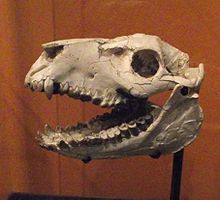- Mesoreodon
-
Mesoreodon
Temporal range: early Miocene
skull of Mesoreodon sp. Scientific classification Kingdom: Animalia Phylum: Chordata Class: Mammalia Order: Artiodactyla Family: †Merycoidodontidae Subfamily: †Merycoidodontinae Genus: †Mesoreodon Type species †Mesoreodon major Mesoreodon is an extinct genus of terrestrial herbivore of the family Merycoidodontidae, subfamily Merycoidodontinae (the oreodonts), endemic to North America during the Whitneyan stage of the Oligocene-Miocene epochs (33—20.6 mya) existing for approximately 12.4 million years.[1]
Contents
Taxonomy
Mesoreodon was named by Scott (1893) and its type is Mesoreodon chelonyx. It was synonymized subjectively with Eporeodon by Lander (1998). It was assigned to Merycoidodontidae by Stevens and Stevens (1996).
Morphology
It was a large animal and ate the numerous low-growing plants and early grasses that sprung up on the plains of North America. It had a rather robust jaw, and like all oreodonts, sharp canine teeth.
Unlike many other oreodonts, who were restricted to certain habitats and places, Mesoreodon seemed to have been a cosmopolite. Fossils of Mesoreodon have been found in the Miocene deserts of California, the prairies of Nebraska, Wyoming, and South Dakota, southeastern Idaho, John Day Fossil Beds in Oregon, and Florida. In fact, Mesoreodon is the only Florida oreodont known from a complete skeleton, odd, since oreodonts had a continent-wide dominance until their extinction. They lived in all environments, and must have been very adaptable.
Mesoreodon had ossified vocal cords; the only other animal to have these in modern times is the howler monkey.[2] Mesoreodon may have been a "screaming oreodont" using loud noises to intimidate its enemies and rivals.
Four specimens were examined by M. Mendoza for body mass and estimated to have a weight of:
- Specimen 1: 228.6 kg (504 lbs).
- Specimen 2: 162.2 kg (357.5 lbs).
- Specimen 3: 144.8 kg (319.2 lbs).
- Specimen 4: 202.4 kg (446.2 lbs).[3]
Fossil distribution
Fossils were uncovered from Florida to California, Oregon, Montana, and Nebraska.
References
- ^ PaleoBiology Database: Mesoreodon, basic info
- ^ C.C. O'Harra (1920). Rapid City, SD: South Dakota School of Mines. pp. 181.
- ^ M. Mendoza, C. M. Janis, and P. Palmqvist. 2006. Estimating the body mass of extinct ungulates: a study on the use of multiple regression. Journal of Zoology
Additional References
- San Diego Museum of Natural History
- Idaho Museum of Natural History, Collections
Categories:- Oreodonts
- Miocene mammals
- White River Fauna
Wikimedia Foundation. 2010.
